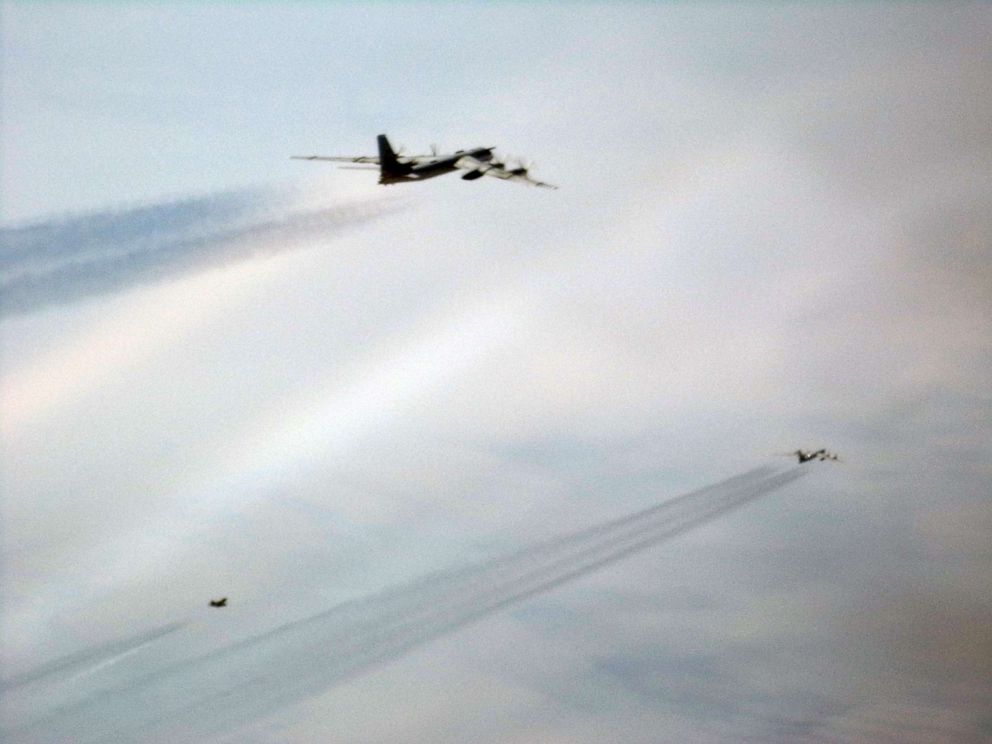For 2nd day in a row, US military jets intercept Russian bombers off Alaska
The Russian aircraft stayed in international airspace.
For a second day in a row, U.S. Air Force F-22 fighters intercepted Russian aircraft that entered the Alaskan Air Defense Identification Zone (ADIZ).
The Russian aircraft remained in international airspace and never entered U.S. airspace Tuesday, but this time, the Russian planes flew in and out of the Alaska Air Defense Identification Zone that stretches 200 miles from the Alaska coastline.

"Two pairs of F-22 fighter jets, each with an E-3 intercepted Tu-95 bombers Su-35 fighter jets entering the Alaskan ADIZ May 21. The bombers entered the ADIZ and were intercepted by two F-22s, exited and then re-entered the Alaskan ADIZ accompanied by two Su-35 fighter jets," according to a NORAD statement. E-3 AWAC aircraft provide airborne radar coordination and surveillance.
"NORAD committed an additional two F-22s and E-3 to relieve the initial intercept aircraft," the statement continued. "A KC-135 refueling aircraft supported both of NORAD’s intercept teams. The Russian aircraft remained in international airspace and at no time entered U.S. or Canadian sovereign airspace."
NORAD said this week's intercepts mark the fourth and fifth intercepts of Russian aircraft this year.
Two Russian Tu-95 bombers and two Su-35 fighters were involved in Tuesday's incident.
On Monday, a mix of four Tu-95 bombers and two Su-35 fighters were intercepted by four American F-22s.
The Alaskan ADIZ is airspace that stretches 200 miles from the coastline and is monitored in the interest of national security. U.S. territorial airspace begins 12 miles from the coastline.
NORAD, a joint U.S.-Canadian military command, sends military aircraft to identify any unidentified aircraft transiting through the American or Canadian ADIZ's.
The Russian flights this week are the first to occur close to Alaska since January, when Russian bombers entered Canada's ADIZ and were intercepted by both Canadian and U.S. aircraft.

The Russian Defense Ministry said in its own statement on Tuesday that "Four Tu-95ms strategic missile carriers of the Russian Aerospace Forces made scheduled sorties over the neutral waters of the Chukotka, Bering and Okhotsk seas, as well as along the western coast of Alaska and the northern coast of the Aleutian Islands."
"At certain stages of the route, Russian aircraft were escorted by F-22 fighter jets of the USAF," according to the statement. "The total flight time exceeded 12 hours."
"All flights of the Russian Air and Space Force are carried out in strict accordance with the International Airspace Management System without violating the borders of other states," it added.
It takes a bit of effort for the Russian military to undertake long-range bomber missions to far eastern Russia and the waters off of Alaska. Russia's long-range bomber fleet is positioned in central and western Russia, meaning the bombers and their maintenance teams are flown to eastern Russian airbases so they can undertake these types of missions.
Over the last two years, Russian missions close to Alaska have occurred two to three times a year.




